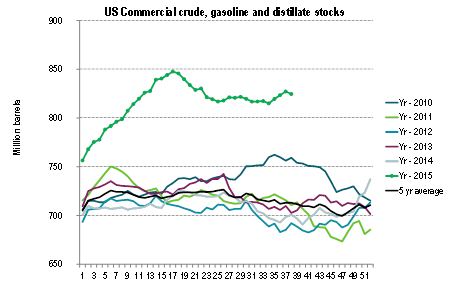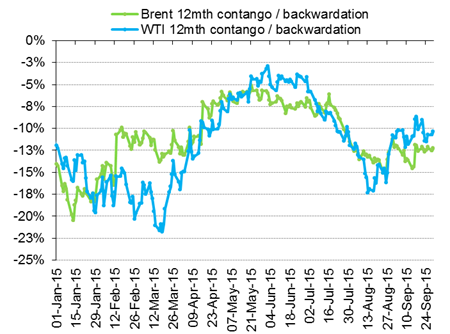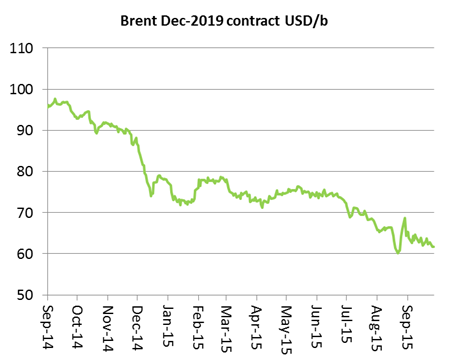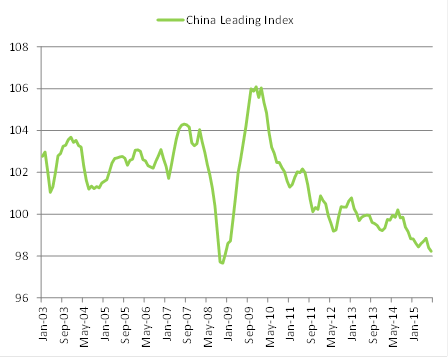Analys
Crude oil comment – Hard to be bullish for the coming 6 months

 Crude oil price action – Down and then back towards the $48/b converging point – for now
Crude oil price action – Down and then back towards the $48/b converging point – for now- Crude oil comment – Hard to be bullish for the coming 6 months
- Graph: US commercial crude and product stocks – on par with two years production from US frack log
- Graph: Less Brent crude 12mth contango lately, but mostly since longer dated contracts are falling
- Graph: The relentless decline of the Brent crude oil December 2019 contract
- Graph: China Leading Index inched yet lower to 98.23 and the lowest since 2009
Crude oil price action – Down and then back towards the $48/b converging point – for now
Brent crude oil traded down 2.6% yesterday to $47.34/b amid a broad based sell-off in European and US equities (-2.6%). Growth concerns for China (industrial profits down 8.8% y/y in August) and the close to 30% drop in Glencore shares helped to drive the bearish sentiment. Do note that Industrial metals only lost 1% so there was not really much of a shake-out in metals on the back of rising China concerns yesterday. Note that while Brent crude saw a percentage wise large drop yesterday, it did not stray too far from the $48/b line which has been a converging price point lately. Today Asia is in the red following the US from last night, but US equities are rebounding. Also Brent crude is rebounding today to $47.7/b and is closing in on the $48/b level again.
Crude oil comment – Hard to be bullish for the coming 6 months
It is difficult to be bullish for the coming 6 months. First out in October and November is the refining turnaround season where refineries now increasingly are taken off-line for maintenance and adjustments ahead of the Northern hemisphere winter season. As this happens more crude oil is left in the market as refineries are not consuming it. Chinese refineries are also projected to process some 250 kb/d to 400 kb/d less in Q4-15 than in Q3-15. At the same time crude oil production in the North Sea is increasing into October and may rise further in November and December, potentially to multi year high. While Q4 is normally a strong demand period of the year it also marks the entrance into demand weakness in Q1 and Q2. We are quite confident that OPEC will not trim its production at its December 4 meeting in Vienna. We are also quite confident that Iran will increase exports of crude oil in Q1 and Q2 as sanctions are lifted and that we overall will get yet another strong rise in global oil stocks in 1H-16. Global oil inventories are already very high with commercial OECD stocks up 272 mb y/y in July to 2972 mb. Of this the US account for 825 mb of crude, gasoline and distillates with a y/y rise of 124 mb (September). On top of this we have the so called US fracklog of drilled wells that have not yet been fracked and put into production. It is difficult to know the size of the fracklog exactly but one estimate places it at around 4500 wells. If we view the fracklog as a kind of oil storage, then 4500 wells amounts to around 800 mb of crude oil that can be put into the market over two years. In other words if all these 4500 wells were producing for two years they would yield some 800 mb of crude oil. After those two years comes the tail-production which will yield even more oil, but over quite a few years.
Counter to this however is the intensifying credit and liquidity situation for the many smaller US shale oil players which will lead to continued declining US crude oil production. Overall however there is limited risk to the upside with so much oil at hand in stocks around the world as well as the US fracklog. In a slightly longer perspective towards the end of 2016 deciding whether the market will be in surplus or deficit in Q4-16 is highly uncertain and will amongst other things depend highly on OPEC production. OPEC has increased production by between 1-2 mb/d this year with main contributors being Iraq and Saudi Arabia. While we expect increasing exports from Iran, it is highly uncertain whether we will see the same increase from Iraq and Saudi Arabia in 2016 as in 2015.
US commercial crude and product stocks – on par with two years production from US frack log
Two years of production from the US fracklog of yet unfracked, but drilled wells will yield crude oil in a magnitude of the current US commercial oil inventories.
Less Brent crude 12mth contango lately, but mostly since longer dated contracts are falling
A key factor here is however that this is not so much to do with strengthening in the front end of the curve, but more to do with a relentless decline in longer dated contracts.
The relentless decline of the Brent crude oil December 2019 contract
The front end of the Brent crude oil curve seems to be very well supported at the $48/b level for the time being. However as the longer dated contracts like the Dec-19 contract ticks lower and lower it forces the curve to be flatter with less contango. If stocks are to increase yet further, which is our base case into 1H-16, an increase in the contango will however be needed. If the longer dated contracts continue to push lower or just stay steady at current level, then the front end contract will need to move lower in order to create the necessary contango to hold increasing storage. At the moment we expect the longer dated contracts to continue lower as producers need to hedge out on the curve while consumer will preferred to purchase oil more towards the front end of the curve in order to utilize contango and low spot crude oil prices.
And then one last graph for the China bears. The China Leading Index inched yet lower to 98.23 and the lowest level since 2009.
Watch out for China PMI manufacturing and services index on Thursday this week.
Bjarne Schieldrop
Chief analyst, Commodities
SEB Markets
Merchant Banking
Analys
Brent slips to USD 64.5: sanction doubts and OPEC focus reduce gains

After reaching USD 66.78 per barrel on Friday afternoon, Brent crude has since traded mostly sideways, yet dipping lower this morning. The market appears to be consolidating last week’s sharp gains, with Brent now easing back to around USD 64.5 per barrel, roughly USD 2.3 below Friday’s peak but still well above last Monday’s USD 60.07 low.

The rebound last week was initially driven by Washington’s decision to blacklist Russia’s two largest oil producers, Rosneft and Lukoil, which together account for nearly half of the country’s crude exports. The move sparked a wave of risk repricing and short covering, with Brent rallying almost 10% from Monday’s trough. Yet, the market is now questioning the actual effectiveness of the sanctions. While a full blacklisting sounds dramatic, the mechanisms for enforcement remain unclear, and so far, there are no signs of disrupted Russian flows.
In practice, these measures are unlikely to materially affect Russian supply or revenues in the near term, yet we have now seen Indian refiners reportedly paused new orders for Russian barrels pending government guidance. BPCL is expected to issue a replacement spot tender within 7–10 days, potentially sourcing crude from non-sanctioned entities instead. Meanwhile, Lukoil is exploring the sale of overseas assets, and Germany has requested extra time for Rosneft to reorganize its refining interests in the country.
The broader market focus is now shifting toward this week’s Fed decision and Sunday’s OPEC+ meeting, both seen as potential short-term price drivers. Renewed U.S.-China trade dialogue ahead of Trump’s meeting with President Xi Jinping in South Korea is also lending some macro support.
In short, while the White House’s latest move adds to geopolitical noise, it does not yet represent a true supply disruption. If Washington had intended to apply real pressure, it could have advanced the long-standing Senate bill enforcing secondary sanctions on buyers of Russian oil, legislation with overwhelming backing, or delivered more direct military assistance to Ukraine. Instead, the latest action looks more like political theatre than policy shift, projecting toughness without imposing material economic pain.
Still, while the immediate supply impact appears limited, the episode has refocused attention on Russia’s export vulnerability and underscored the ongoing geopolitical risk premium in the oil market. Combined with counter-seasonal draws in U.S. crude inventories, record-high barrels at sea, and ongoing uncertainty ahead of the OPEC+ meeting, short-term fundamentals remain somewhat tighter than the broader surplus story suggests.
i.e., the sanctions may prove mostly symbolic, but the combination of geopolitics and uneven inventory draws is likely to keep Brent volatile around the low to mid-USD 60s in the days ahead.
Analys
Sell the rally. Trump has become predictable in his unpredictability

Hesitant today. Brent jumped to an intraday high of $66.36/b yesterday after having touched an intraday low of $60.07/b on Monday as Indian and Chinese buyers cancelled some Russian oil purchases and instead redirected their purchases towards the Middle East due to the news US sanctions. Brent is falling back 0.4% this morning to $65.8/b.

It’s our strong view that the only sensible thing is to sell this rally. In all Trump’s unpredictability he has become increasingly predictable. Again and again he has rumbled about how he is going to be tough on Putin. Punish Putin if he won’t agree to peace in Ukraine. Recent rumbling was about the Tomahawk rockets which Trump threatened on 10 October and 12 October to sell/send to Ukraine. Then on 17 October he said that ”the U.S. didn’t want to give away weapons (Tomahawks) it needs”.
All of Trump’s threats towards Putin have been hot air. So far Trump’s threats have been all hot air and threats which later have evaporated after ”great talks with Putin”. After all these repetitions it is very hard to believe that this time will be any different. The new sanctions won’t take effect before 21. November. Trump has already said that: ”he was hoping that these new sanctions would be very short-lived in any case”. Come 21. November these new sanctions will either evaporate like all the other threats Trump has thrown at Putin before fading them. Or the sanctions will be postponed by another 4 weeks or 8 weeks with the appearance that Trump is even more angry with Putin. But so far Trump has done nothing that hurt Putin/Russia. We can’t imagine that this will be different. The only way forward in our view for a propre lasting peace in Ukraine is to turn Ukraine into defensive porcupine equipped with a stinging tail if need be.
China will likely stand up to Trump if new sanctions really materialize on 21 Nov. Just one country has really stood up to Trump in his tariff trade war this year: China. China has come of age and strength. I will no longer be bullied. Trump upped tariffs. China responded in kind. Trump cut China off from high-end computer chips. China put on the breaks on rare earth metals. China won’t be bullied any more and it has the power to stand up. Some Chinese state-owned companies like Sinopec have cancelled some of their Russian purchases. But China’s Foreign Ministry spokesperson Guo Jiakun has stated that China “oppose unilateral sanctions which lack a basis in international law and authorization of the UN Security Council”. Thus no one, not even the US shall unilaterally dictate China from whom they can buy oil or not. This is yet another opportunity for China to show its new strength and stand up to Trump in a show of force. Exactly how China choses to play this remains to be seen. But China won’t be bullied by over something as important as its oil purchases. So best guess here is that China will defy Trump on this. But probably China won’t need to make a bid deal over this. Firstly because these new sanctions will either evaporate as all the other threats or be postponed once we get to 21 November. Secondly because the sanctions are explicit towards US persons and companies but only ”may” be enforced versus non-US entities.
Sanctions is not a reduction in global supply of oil. Just some added layer of friction. Anyhow, the new sanctions won’t reduce the supply of Russian crude oil to the market. It will only increase the friction in the market with yet more need for the shadow fleet and ship to ship transfer of Russian oil to dodge the sanctions. If they materialize at all.
The jump in crude oil prices is probably due to redirections of crude purchases to the Mid-East and not because all speculators are now turned bullish. Has oil rallied because all speculators now suddenly have turned bullish? We don’t think so. Brent crude has probably jumped because some Indian and Chinese oil purchasers of have redirected their purchases from Russia towards the Mid-East just in case the sanctions really materializes on 21 November.
Analys
Brent crude set to dip its feet into the high $50ies/b this week

Parts of the Brent crude curve dipping into the high $50ies/b. Brent crude fell 2.3% over the week to Friday. It closed the week at $61.29/b, a slight gain on the day, but also traded to a low of $60.14/b that same day and just barely avoided trading into the $50ies/b. This morning it is risk-on in equities which seems to help industrial metals a little higher. But no such luck for oil. It is down 0.8% at $60.8/b. This week looks set for Brent crude to dip its feet in the $50ies/b. The Brent 3mth contract actually traded into the high $50ies/b on Friday.

The front-end backwardation has been on a weakening foot and is now about to fully disappear. The lowest point of the crude oil curve has also moved steadily lower and lower and its discount to the 5yr contract is now $6.8/b. A solid contango. The Brent 3mth contract did actually dip into the $50ies/b intraday on Friday when it traded to a low point of $59.93/b.
More weakness to come as lots of oil at sea comes to ports. Mid-East OPEC countries have boosted exports along with lower post summer consumption and higher production. The result is highly visibly in oil at sea which increased by 17 mb to 1,311 mb over the week to Sunday. Up 185 mb since mid-August. On its way to discharge at a port somewhere over the coming month or two.
Don’t forget that the oil market path ahead is all down to OPEC+. Remember that what is playing out in the oil market now is all by design by OPEC+. The group has decided that the unwind of the voluntary cuts is what it wants to do. In a combination of meeting demand from consumers as well as taking back market share. But we need to remember that how this plays out going forward is all at the mercy of what OPEC+ decides to do. It will halt the unwinding at some point. It will revert to cuts instead of unwind at some point.
A few months with Brent at $55/b and 40-50 US shale oil rigs kicked out may be what is needed. We think OPEC+ needs to see the exit of another 40-50 drilling rigs in the US shale oil patches to set US shale oil production on a path to of a 1 mb/d year on year decline Dec-25 to Dec-26. We are not there yet. But a 2-3 months period with Brent crude averaging $55/b would probably do it.
Oil on water increased 17 mb over the week to Sunday while oil in transit increased by 23 mb. So less oil was standing still. More was moving.

Crude oil floating storage (stationary more than 7 days). Down 11 mb over week to Sunday

The lowest point of the Brent crude oil curve versus the 5yr contract. Weakest so far this year.

Crude oil 1mth to 3mth time-spreads. Dubai held out strongly through summer, but then that center of strength fell apart in late September and has been leading weakness in crude curves lower since then.

-

 Nyheter3 veckor sedan
Nyheter3 veckor sedanGoldman Sachs höjer prognosen för guld, tror priset når 4900 USD
-

 Nyheter4 veckor sedan
Nyheter4 veckor sedanBlykalla och amerikanska Oklo inleder ett samarbete
-

 Nyheter4 veckor sedan
Nyheter4 veckor sedanGuld nära 4000 USD och silver 50 USD, därför kan de fortsätta stiga
-

 Nyheter2 veckor sedan
Nyheter2 veckor sedanLeading Edge Materials är på rätt plats i rätt tid
-

 Nyheter3 veckor sedan
Nyheter3 veckor sedanNytt prisrekord, guld stiger över 4000 USD
-

 Nyheter4 veckor sedan
Nyheter4 veckor sedanEtt samtal om guld, olja, koppar och stål
-

 Analys4 veckor sedan
Analys4 veckor sedanOPEC+ will likely unwind 500 kb/d of voluntary quotas in October. But a full unwind of 1.5 mb/d in one go could be in the cards
-

 Nyheter4 veckor sedan
Nyheter4 veckor sedanNeptune Energy bekräftar enorma litiumfyndigheter i Tyskland












